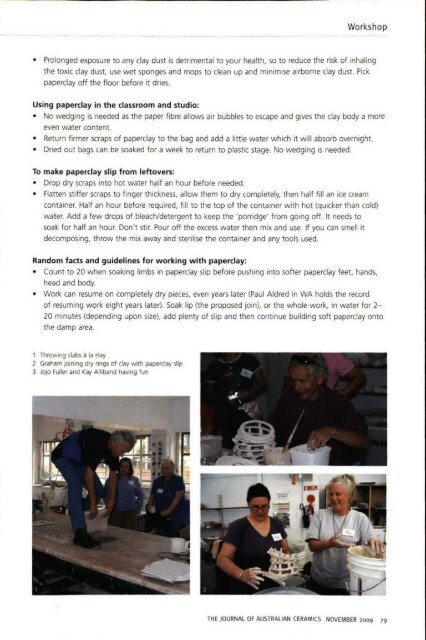The Journal of Australian Ceramics Vol 48 No 3 November 2009
You also want an ePaper? Increase the reach of your titles
YUMPU automatically turns print PDFs into web optimized ePapers that Google loves.
Works hop<br />
• Prolonged exposure to any clay dust is detrimental to your health, so to reduce the risk <strong>of</strong> inhaling<br />
the toxic clay dust, use wet sponges and mops to clean up and minimise airborne clay dust. Pick<br />
paperclay <strong>of</strong>f the floor before it dries.<br />
Using paperclay in the classroom and studio:<br />
• <strong>No</strong> wedging is needed as the paper fibre allows air bubbles to escape and gives the clay body a more<br />
even water content.<br />
• Return firmer scraps <strong>of</strong> paperclay to the bag and add a little water which it will absorb overnight.<br />
• Dried out bags can be soaked for a week to return to plastic stage. <strong>No</strong> wedging is needed.<br />
To make paperclay slip f rom leftovers:<br />
• Drop dry scraps into hot water half an hour before needed.<br />
• Flatten stiffer scraps to finger thickness, allow them to dry completely, then half fill an ice cream<br />
container. Half an hour before required, fill to the top <strong>of</strong> the container with hot (quicker than cold)<br />
water. Add a few drops <strong>of</strong> bleach/detergent to keep the 'porridge' from going <strong>of</strong>f. It needs to<br />
soak for half an hour. Don't stir. Pour <strong>of</strong>f the excess water then mix and use. If you can smell it<br />
decomposing, throw the mix away and sterilise the container and any tools used.<br />
Random facts and guidelines for working with paperclay:<br />
• Count to 20 when soaking limbs in paperciay slip before pushing into s<strong>of</strong>ter paperciay feet, hands,<br />
head and body.<br />
• Work can resume on completely dry pieces, even years later (Paul Aldred in WA holds the record<br />
<strong>of</strong> resuming work eight years later). Soak lip (the proposed join), or the whole work, in water for 2-<br />
20 minutes (depending upon size), add plenty <strong>of</strong> slip and then continue building s<strong>of</strong>t paperclay onto<br />
the damp area.<br />
1 Throwing slabs ~ la Hay<br />
2 Graham joining dry rings <strong>of</strong> clay with paperclay slip<br />
3 Jojo Fuller and Kay Alliband having fun<br />
THE 10URNAl OF AUSTRALIAN CERAMICS NOVEMBER <strong>2009</strong> 79


















